
Hi Everyone!
Our next two blog posts will deal with some common roofing issues that homeowners face in Australia! In this blog we’ll be covering:
- Galvanic corrosion
- Roof Leakage / leaks
- Mould & Watermarks
Read on for some handy information on how these issues effect your roof and your home and some potential solutions that you can implement to minimise the problems!
GALVANIC CORROSION
What is it?
In the building industry, and in particular with external cladding exposed to the elements, it’s important that different types of metals aren’t installed in contact with each other to avoid problematic galvanic corrosion. Galvanic corrosion occurs when one type of metal is in contact with dissimilar, more ‘noble’ metal in the presence of an electrolyte – for example water.
The below diagram illustrates varying degrees of susceptibility to corrosion. The further a coupling of metals gets from the centre of the chart, the greater chance of corrosion to the less noble metal of the couple.
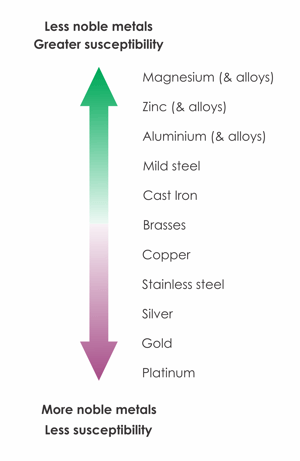
Where does it occur?
Galvanic corrosion can occurs anywhere, but happens most commonly on roofs, where the presence of water at some point or another is guaranteed. It’s particularly common on older Queenslander roofs that were installed with galvanised metal sheets, as well as instances where:
- Stainless steel self-drilling roof screws are used to fix Colorbond painted steel roof sheeting
- Zincalume steel sheeting is installed with lead or galvanised flashings and gutters.
- Galvanised roof sheets with Zincalume roof sheets, flashings and gutters.
Though not actually in contact, even water running from an upper galvanised roof to a lower Zincalume roof will start to show signs of galvanic corrosion over time, which you will see as discolouration in the Zinc sheets.
What does it look like?
Although the term ‘rusting’ is used to describe a different, specific type of corrosion, galvanic corrosion looks like what we typically refer to as ‘rust.
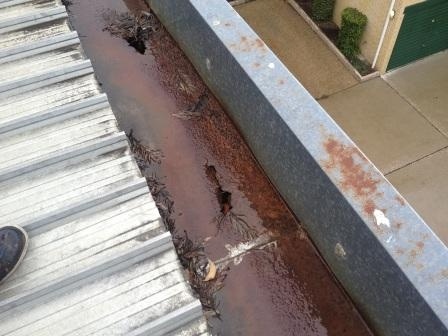
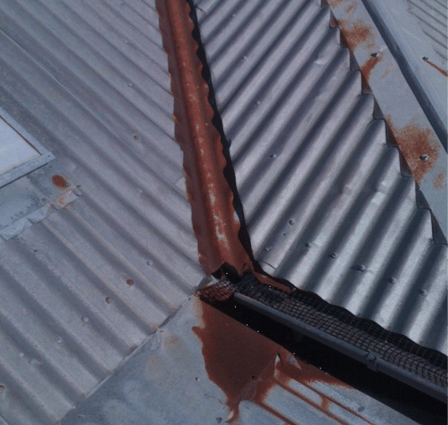
Considerations
Most roofing companies are well educated on the pitfalls of galvanic corrosion and know what to look for when inspecting existing roofs, as well as what to consider when installing new roofs.
A full roof replacement should generally be of no concern, as the same metals are used through the roof system. For partial roof replacements, or roof replacements where existing gutters are to remain in place however, it is critical that consideration be given to the pre-existing metal and what is being installed.
Ensuring the same type of metal is installed is the easiest way to avoid problems, but galvanised and Colorbond roof sheeting will also prevent corrosion occurring. Colorbond roof sheeting has a higher resistance to galvanic corrosion because of the paint layer covering the Zincalume is chemically non-reactive.
For more information about the compatibility of certain types of metals used on your home, have a look at the video we posted last year: 'Are all metals compatible?'
If you’re unsure about your roofing materials, don’t hesitate to get in contact with Vantage Point Roofing; ensuring the correct precautions are in place for your roof replacement will mean the performance and appearance of your roof are maintained for many years to come!
LEAKS
Your roof is arguably the most important component of your home - it’s really the only thing keeping the water out! So when you find that it isn’t doing its job properly and water is leaking into your roof cavity and home, it’s more serious than simply putting out the pots and pans until the rain passes. It’s possible that a leak may have developed and been causing damage within your roof cavity long before it makes itself known to you (see the next section of the blog for info on mould and watermarking) – so, if you’re seeing tell-tale signs, or suspect a leak – it’s best to act NOW and get your roof watertight again!
Possible Causes
Leaks can be time consuming, inconvenient and costly to locate and repair. If your roof is leaking however, there are a few likely areas that professional roof plumbers will address when attempting to locate the root cause of the issue:
- Incorrectly installed materials.
- Poorly sealed flashings.
- Rusted or cracked roofing materials.
- Inadequate drainage in heavy rain.
- Loose roof fixings.
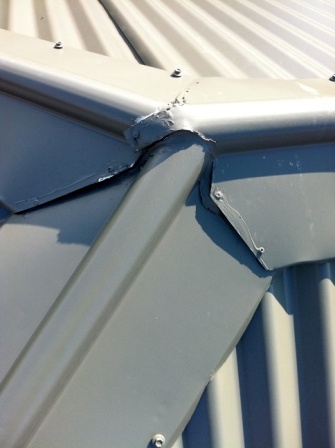
| Poor workmanship, like that in the installation of the ridge capping VPR found in the above picture during an inspection of an existing roof, are often the cause of roof leaks. |
Rectifying the Issue
Repairs
If the problem can be located and rectified with confidence, then a simple repair may get you out of trouble. However, leaks can be elusive, and what might appear as the root cause of the problem might in fact be a reactive symptom to another issue.
Roof replacement
Needless to say, a full roof replacement is the most dependable way to ensure you and your home are protected from the elements for decades to come. Repairs might seem desirable due to the low immediate costs, however, without early identification and rectification, they can drag out with multiple returns to site and cost more money and time in the long run. A roof replacement is a fixed price solution with low to no maintenance and in most cases will outlast you!
If you're still unsure of what the best option for you is, we'd be more than happy to provide you with a free roof inspection where we provide clear expert advice based on the condition of your roof and your personal requirements.
MOULD & WATERMARKS
The most common symptoms of a leaking roof or drainage issues, apart from an active drip, are mould and watermarks.
Watermarks
Blockages of gutters, downpipes and roof valleys can cause water to overflow under the eaves, into the roof cavity and down walls. This in turn can cause issues such, discolouration or water marks. In addition to be unsightly, If left unresolved, particularly for prolonged periods, wood may weaken and rot due to water damage, which undermines the structural integrity of the home. If you have noticed watermarks on your ceiling, it's important to take action as soon as possible, as more serious issues may have been developing within the roof cavity before visible symptoms have appeared on the ceiling.
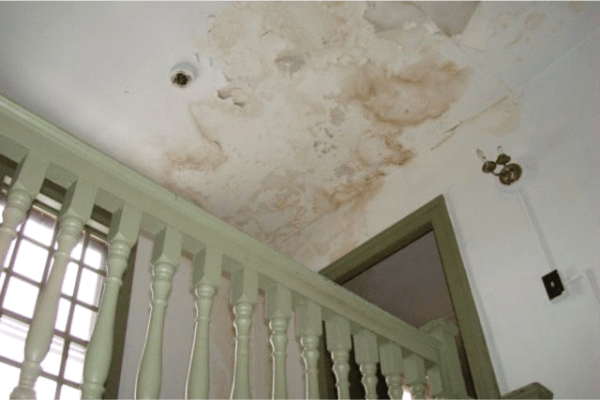
Water marks due to pooling water on the ceiling
Mould
Excess moisture on your property due to water seeping in damaged roof or eave spaces can develop into a damp and/or mould issue. Damp and mould can also affect your immune system, trigger respiratory problems, and can result in a pungent smell and unsightly mould marks throughout the affected areas of the property. Once again, mould is often a symptom of a much more serious underlying issue, so it's important to have a professional roof plumber inspect and diagnose the problem as soon as possible.
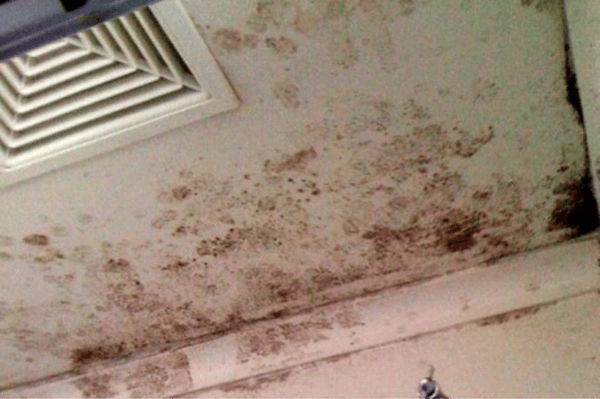 Mould due to excess moisture in the roof cavity
Mould due to excess moisture in the roof cavity
We hope you found the information in this blog useful!
If you'd like any further information on any of the issues above, or would like to discuss other roofing concerns, please don't hesitate to give us a call and have a chat with one of our friendly roofing experts!
1800 476 634
You can also request a complimentary roof inspection and quote by clicking this link:
<--- PREVIOUS: COMMON ROOFING ISSUES 1: Animals, Asbestos, Blockages & Downpipes
Updated 4th Jan 2020


